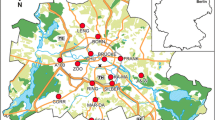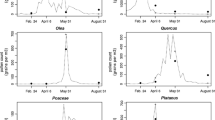Abstract
Large spatial differences in the distribution of three allergologically relevant pollen types for Central Europe—birch, grass, and mugwort—are revealed within a large metropolitan area—Berlin, Germany. The purpose of the study is an examination of the hypothesis that these different pollen exposure conditions can cause different degrees of pollen-induced symptoms within the city. Pollen data from 14 gravimetric traps and one volumetric trap in Berlin and anonymously reported pollen-induced symptom data from the online-based self-documentation tool “Patient’s Hayfever Diary” (PHD) are used for the analysis of temporal and spatial variations of the severity of the overall total symptoms. Geographically localised symptom data are linked to the nearest pollen trap. Statistical analysis is performed using Kendall’s Tau-b. Higher amounts of monitored birch and grass pollen in the peripheral areas of Berlin induce stronger symptoms in PHD users located within suburbs than those located in the city centre. There is no statistical relationship between the varying presence of mugwort pollen in the air and the severity of symptoms. Spatial differences in the pollen-induced symptom severity within a large city coinciding with spatial differences in birch and grass pollen depositions are shown for the first time. Therefore, pollen data from a single trap may not provide an appropriate explanation for differences in pollen-induced symptoms across the city. More detailed and reliable information about the exposure to allergenic pollen can be addressed by installing further traps in order to improve the knowledge about pollen exposure within cities.

Source map: Geoportal Berlin/Postleitzahlen 2015

Source map: Geoportal Berlin/Postleitzahlen 2015

Source map: Geoportal Berlin/Postleitzahlen 2015



Similar content being viewed by others
References
Amt für Statistik Berlin-Brandenburg (2016) Statistisches Jahrbuch 2016. Resource document. Amt für Statistik Berlin-Brandenburg. https://www.statistik-berlin-brandenburg.de/produkte/Jahrbuch/BE_Kap_2016.asp. Accessed 21 August 2017.
Austin, E. J., Gibson, G. J., Deary, I. J., McGregor, M. J., & Dent, J. B. (1998). Individual response spread in self-report scales: Personality correlations and consequences. Personality and Individual Differences, 4(3), 421–438.
Bastl, K., Berger, U., & Kmenta, M. (2015). Der asynchrone Verlauf von allergischen Beschwerden und Pollenbelastungen. JATROS Pneumologie und HNO, 2(15), 51–52.
Bastl, K., Kmenta, M., Jäger, S., Bergmann, K. C., & Berger, U. (2014). Development of a symptom load index: Enabling temporal and regional pollen season comparisons and pointing out the for personalized pollen information. Aerobiologia, 30(3), 269–280.
Berger, U., Jäger, S., Bergmann, K. C. (2011). PHD, the electronic patient’s hayfever diary. ERS Congress Amsterdam, oral presentation. European Respiratory Journal, 38(s55): 569 s, Abstract 3213. http://www.erseducation.org/ersMade/abstract_print_11/main_frameset.htm.
Berger, U., Karatzas, K., Jaeger, S., Voukantsis, D., Sofiev, M., Brandt, O., et al. (2013). Personalized pollen-related symptom-forecast information services for allergic rhinitis patients in Europe. Allergy, 68(8), 963–965.
Bergmann, K. C., Zuberbier, T., Augustin, J., Mücke, H. G., & Straff, W. (2012). Climate change and pollen allergy: Cities and municipalities should take people suffering from pollen allergy into account when planting in public spaces. Allergo Journal, 21(2), 103–107.
Brito, F. F., Gimeno, P. M., Carnes, J., Martin, R., Fernandez-Caldas, E., Lara, P., et al. (2011). Olea europaea pollen counts and aeroallergen levels predict clinical symptoms in patients allergic to olive pollen. Annals of Allergy, Asthma and Immunology, 106(2), 146–152.
Caillaud, D., Martin, S., Segala, C., Besancenot, J. P., Clot, B., & Thibaudon, M. (2014). Effects of airborne birch pollen levels on clinical symptoms of seasonal allergic rhinoconjunctivitis. International Archives of Allergy and Immunology, 163(1), 43–50.
Durham, O. C. (1946). The volumetric incidence of atmospheric allergens. IV. A proposed standard method of gravity sampling, counting, and volumetric interpolation of results. Journal of Allergy, 17(2), 79–86.
Emberlin, J., & Norris-Hill, J. (1991). Spatial variation of pollen deposition in north London. Grana, 30(1), 190–195.
Fan, X., Miller, B. C., Park, K., Winward, B. W., Christensen, M., Grotevant, H. D., et al. (2006). An exploratory study about inaccuracy and invalidity in adolescent self-report surveys. Field Methods, 18(3), 223–244.
Florack, J., Brighetti, M. A., Perna, S., Pizzulli, A., Pizzulli, A., Tripodi, S., et al. (2016). Comparison of six disease severity scores for allergic rhinitis against pollen counts a prospective analysis at population and individual level. Pediatric Allergy and Immunology, 27(4), 382–390.
Frenz, D. A. (2001). Interpreting atmospheric pollen counts for use in clinical allergy: Allergic symptomology. Annals of Allergy, Asthma and Immunology, 86(2), 150–157.
Gibbons, J. D. (1993). Nonparametric measures of association. Thousand Oaks, CA: Sage Publications.
Grouin, J. M., Vicaut, E., Jean-Alphonse, S., Demoly, P., Wahn, U., Didier, A., et al. (2014). The average Adjusted Symptom Score, a new primary efficacy end-point for specific allergen immunotherapy trials. Clinical & Experimental Allergy, 41(9), 1282–1288.
Hirst, J. M. (1952). An automatic volumetric spore trap. The Annals of Applied Biology, 39(2), 257–265.
Hjort, J., Suomi, J., & Käyhkö, J. (2011). Spatial prediction of urban–rural temperatures using statistical methods. Theoretical and Applied Climatology, 106(1), 139–152.
Ishibashi, Y., Ohno, H., Oh-ishi, S., Matsuoka, T., Kizaki, T., & Yoshizumi, K. (2008). Characterization of pollen dispersion in the neighborhood of Tokyo, Japan in the spring of 2005 and 2006. International Journal of Environmental Research and Public Health, 5(1), 76–85.
Jäger, S., Nilsson, S., Berggren, B., Pessi, A. M., Helander, M., & Ramfjord, H. (1996). Trends of some airborne tree pollen in the Nordic countries and Austria, 1980–1993. A comparison between Stockholm, Trondheim, Turku and Vienna. Grana, 35(3), 171–178.
Karatzas, K., Voukantsis, D., Jäger, S., Berger, U., Smith, M., Brandt, O., et al. (2014). The patient’s hay-fever diary: Three-years of results from Germany. Aerobiologia, 30(1), 1–11.
Kiotseridis, H., Cilio, C. M., Bjermer, L., Tunsäter, A., Jacobsson, H., & Dahl, Å. (2013). Grass pollen allergy in children and adolescents-symptoms, health related quality of life and the value of pollen prognosis. Clinical and Translational Allergy. https://doi.org/10.1186/2045-7022-3-19.
Kmenta, M., Bastl, K., Jäger, S., & Berger, U. (2014). Development of personal pollen information—the next generation of pollen information and a step forward for hay fever sufferers. International Journal of Biometeorology, 58(8), 1721–1726.
Kottek, M., Grieser, J., Beck, C., Rudolf, B., & Rubel, F. (2006). World map of the Köppen-Geiger climate classification updated. Meteorologische Zeitschrift, 15(3), 259–263.
Langen, U., Schmitz, R., & Steppuhn, H. (2013). Häufigkeit allergischer Erkrankungen in Deutschland—Ergebnisse der Studie zur Gesundheit Erwachsener in Deutschland (DEGS1). Bundesgesundheitsblatt, 56(5/6), 698–706.
Mitakakis, T. Z., Tovey, E. R., Xuan, W., & Marks, G. B. (2000). Personal exposure to allergenic pollen and mould spores in inland New South Wales, Australia. Clinical & Experimental Allergy, 30(12), 1733–1739.
Pawankar, R., Canonica, G. W., Holgate, S. T., Lockey, R. F., Blaiss, M. S. (2013). World Allergy Organization (WAO) White book on Allergy: Update 2013. Resource document. World Allergy Organization. http://www.worldallergy.org/UserFiles/file/WhiteBook2-2013-v8.pdf. Accessed 29 October 2017.
Penel, V., Calleja, M., Pichot, C., & Charpin, D. (2017). Static and elevated pollen traps do not provide an accurate assessment of personal pollen exposure. European Annals of Allergy and Clinical Immunology, 49(2), 59–65.
Pollenwarndienst (2017). Gratis Pollen App https://www.pollenwarndienst.at/gratis-pollen-app.html. Accessed 29 October 2017.
Schmitz, R., Atzpodien, K., & Schlaud, M. (2012). Prevalence and risk factors of atopic diseases in German children and adolescents. Pediatric Allergy and Immunology, 23, 716–723.
Takasaki, K., Enatsu, K., Kumagami, H., & Takahashi, H. (2009). Relationship between airborne pollen count and treatment outcome in Japanese cedar pollinosis patients. European Archives of Oto-Rhino-Laryngology, 266(5), 673–676.
T. K. (2017) TK-AllergieApp https://www.tk.de/tk/tk/tk-apps/tk-allergieapp/702254. Accessed 29 October 2017.
UN (2015) Population Division (2015). World Urbanization Prospects: The 2014 Revision, (ST/ESA/SER.A/366) Resource document. United Nations, Department of Economic and Social Affairs https://esa.un.org/unpd/wup/Publications/Files/WUP2014-Report.pdf. Accessed 30 October 2017
Voukantsis, D., Berger, U., Tzima, F., Karatzas, K., Jäger, S., Sofiev, et al. (2015). Personalized symptoms forecasting for pollen-induced allergic rhinitis sufferers. International Journal of Biometeorology, 59(7), 889–897.
Waisel, Y., Mienis, Z., Kosman, E., & Geller-Bernstein, C. (2004). The partial contribution of specific airborne pollen to pollen induced allergy. Aerobiologia, 20(4), 197–208.
Weinberger, K. R., Kinney, P. L., Robinson, G. S., Sheehan, D., Kheirbek, I., Matte, T. D., et al. (2016). Levels and determinants of tree pollen in New York City. Journal of Exposure Science and Environmental Epidemiology. https://doi.org/10.1038/jes.2016.72.
Werchan, M., Sehlinger, T., Goergen, F., & Bergmann, K. C. (2017a). The pollator: A personal pollen sampling device. Allergo Journal International. https://doi.org/10.1007/s40629-017-0034-y.
Werchan, B., Werchan, M., Mücke, H. G., Gauger, U., Simoleit, A., Zuberbier, T., et al. (2017b). Spatial distribution of allergenic pollen through a large metropolitan area. Environmental Monitoring Assessment. https://doi.org/10.1007/s10661-017-5876-8.
Acknowledgments
The authors thank the anonymous reviewers for their valuable comments. The study was supported by the German Environment Agency.
Author information
Authors and Affiliations
Corresponding author
Rights and permissions
About this article
Cite this article
Werchan, B., Werchan, M., Mücke, HG. et al. Spatial distribution of pollen-induced symptoms within a large metropolitan area—Berlin, Germany. Aerobiologia 34, 539–556 (2018). https://doi.org/10.1007/s10453-018-9529-3
Received:
Accepted:
Published:
Issue Date:
DOI: https://doi.org/10.1007/s10453-018-9529-3




